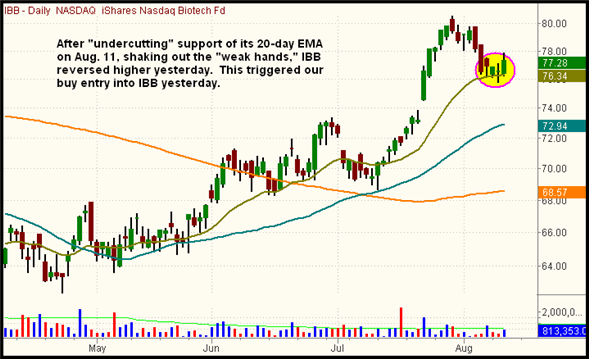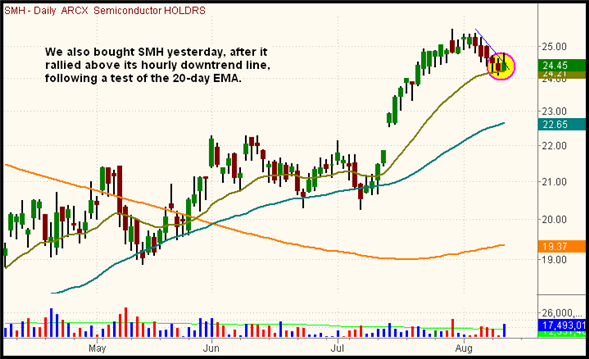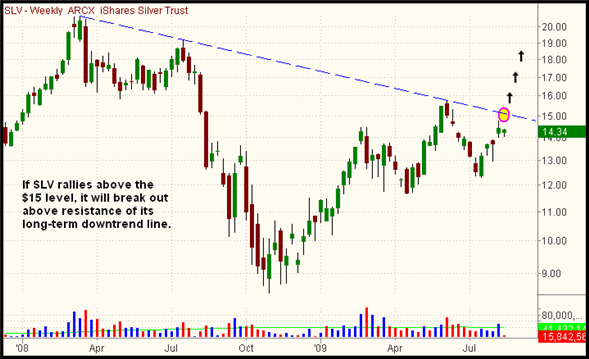|
The Wagner Daily ETF Report For August 13
With price action that was exactly the opposite of the previous day's session, the major indices scored a round of sizeable gains that erased the previous day's losses. Stocks opened near the flat line, trended higher throughout the first half of the day, and then displayed the usual whippiness and indecision after the 2:15 pm ET Fed announcement on economic policy (which harbored no surprises). The S&P 500 jumped 1.2%, the Dow Jones Industrial Average 1.3%, and the Nasdaq Composite 1.5%. The small-cap Russell 2000 led the way with a 1.8% gain, as the S&P Midcap 400 advanced 1.4%. Trading in the final ninety minutes was volatile and erratic, but the main stock market indexes eventually settled near the upper third of their intraday ranges.
Turnover rose across the board, enabling both the S&P and Nasdaq to log a bullish "accumulation day." Total volume in the NYSE ticked 2% higher, while volume in the Nasdaq rose 13% above the previous day's level. In the preceding session, stocks suffered a bearish "distribution day" by falling on higher volume, so it was positive that the market quickly snapped back with a round of even higher volume gains. Nevertheless, turnover in the Nasdaq remained lighter than average. Market internals in both exchanges were quite solid. In the NYSE, advancing volume exceeded declining volume by a margin of 4 to 1. The Nasdaq adv/dec volume ratio was positive by 11 to 2.
Over the past two weeks, we've been discussing the possibility of the major indices pulling back to support of their 20-day moving averages, as well as the possibility stocks will simply break out to make another leg higher, without first going through a significant price correction. But based on recent price action, it's starting to look more and more like the broad market may simply be entering a prolonged period of sideways, range-bound trading. From day-to-day (and even intraday), stocks have been see-sawing between positive and negative territory. Further, volume patterns have started to become mixed as well, showing occasional bouts of both institutional selling and buying. In case the current sideways range becomes prolonged, there are two tips to help manage such price action.
First, consider avoiding trades in broad-based ETFs such as the S&P 500 SPDR (SPY) and Nasdaq 100 Tracking Stock (QQQQ). If the overall market is stuck in an indecisive, sideways range, the last type of ETF you want to be positioned in are any that closely mirror that choppy trading of the broad market. Instead, focus on specific industry sector ETFs with relative strength, international ETFs, and ETFs with a low correlation to the stock market (commodity, currency, and/or fixed-income). Specifically, you may wish to adopt a strategy of buying ETFs with relative strength at low-risk entry points, such as when they retrace to areas of support. In our August 11 commentary, we pointed out the developing pullback setups in iShares Nasdaq Biotech (IBB) and Semiconductor HOLDR (SMH) for that reason. Yesterday, both of those ETFs triggered our buy entry levels by rallying above resistance of their short-term, hourly downtrend lines, after bouncing off support of their 20-day exponential moving averages. Updated daily charts of IBB and SMH are shown below:


The second suggestion for trading in range-bound markets is to guard against overtrading. Sideways markets have a way of fouling up nice-looking trade setups that otherwise appear poised for substantial follow-through. Even the strongest ETFs have a reduced chance of sustaining steady trends when the broad market is sideways, so be careful not to quickly jump into everything that appears to be trending. Rather, take the time to carefully assess a reward-risk ratio on every trade. If the setup requires a stop price that is more than half the point value of your realistic target price, it may be better to pass on entering the trade. Doing so will ensure all your trades carry a reward-risk ratio of at least 2 to 1. By limiting trades to those with reward-risk ratios of at least 2 to 1, one can still be net profitable with a winning trade ratio of 50% or less. Conversely, if entering trades with less than a 2 to 1 reward-risk ratio, you'll need to ensure a consistent batting average greater than 50%.
Going into today's session, keep an eye on iShares Silver Trust (SLV), as well as the other precious metals ETFs. On the weekly chart below, notice SLV is nearing a major breakout above a downtrend line that has been in place for nearly a year and a half. With SLV trading approximately 3% higher in today's pre-market session, there is a chance that breakout will come today:

Though we do not have SLV in our portfolio, we are positioned in Gold Double Long (DGP), another precious metal ETF. Like silver, spot gold is also poised to bust through resistance of a long-term downtrend line. If/when it does, we may add to our position in DGP. Other commodity ETFs, such as crude oil, also look poised to resume their recent bullishness in the coming days.
Open ETF positions:
Long - IBB, SMH, DGP, DBO, FXB
Short - (none)
Deron Wagner is the Founder and Head Trader of both Morpheus Capital LP, a U.S. hedge fund, and MorpheusTrading.com, a trader education firm.
|